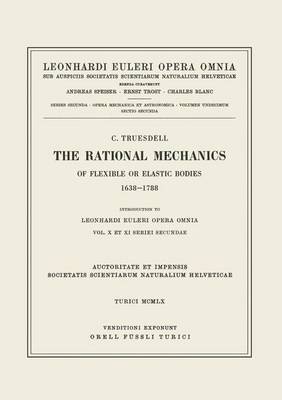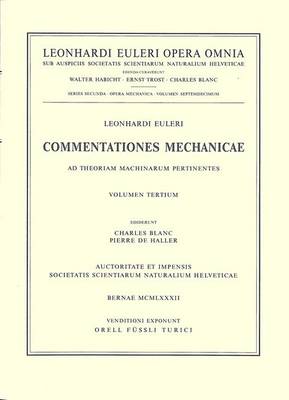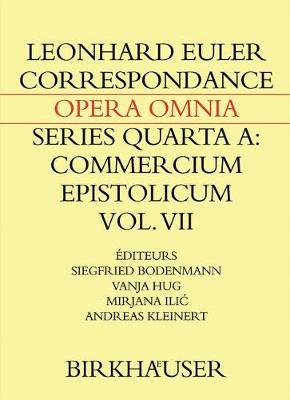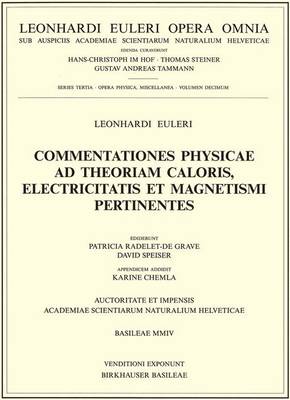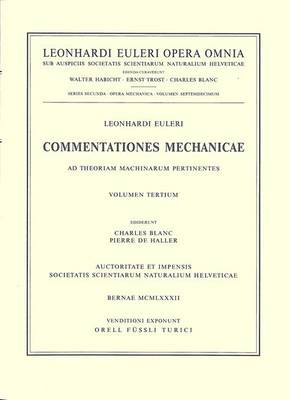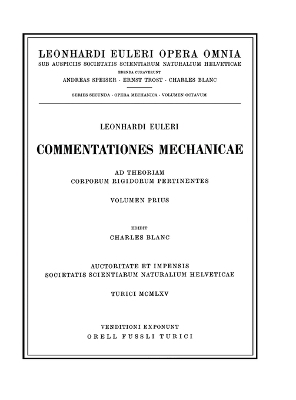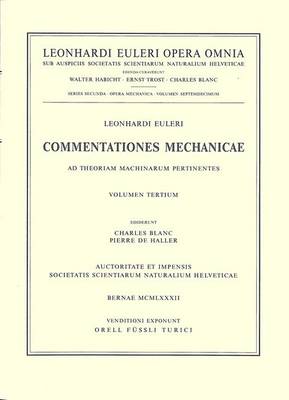Leonhard Euler, Opera Omnia / Opera Mechanica Et Astronomica
9 total works
2 / 11,2
The Rational Mechanics of Flexible or Elastic Bodies 1638 - 1788
by Leonhard Euler
2 / 24
2 / 25
Commentationes Astronomicae Ad Theoriam Perturbationum Pertinentes
by Leonhard Euler
SER 4A / v.7
This volume of the Opera omnia includes Euler's correspondences in French with his Swiss countrymen Louis Bertrand, Charles Bonnet, Marc-Michel Bousquet, Jean de Castillon, Gabriel Cramer, Philibert Cramer, Gaspard Cuentz, Albrecht von Haller, Georges-Louis Lesage et Johann Caspar Wettstein, and one letter to the German Johann Michael von Loen who is mentioned in the Euler-Bertrand correspondence. The first letter from Euler to d'Alembert recently rediscovered has been added as supplement.
Whereas the correspondence with Gabriel Cramer and Georges-Louis Lesage deals mainly with mathematical and physical subjects (Cramer's rule, Cramer's paradox, Lesage's theory of gravity), many letters exchanged with other Swiss correspondents provide new information about Euler's non-scientific activities, like the commerce of almanacs, negotiations with publishers, the support of young scientists in search of a position, and a variety of private matters.
-----
Ce volume contient les correspondances qu'Euler a entretenues avec plusieurs compatriotes suisses en langue francaise. Il s'agit de Louis Bertrand, Charles Bonnet, Marc-Michel Bousquet, Jean de Castillon, Gabriel Cramer, Philibert Cramer, Gaspard Cuentz, Albrecht von Haller, Georges-Louis Lesage et Johann Caspar Wettstein. Bien qu'il n'ait pas ete suisse, une lettre de Johann Michael von Loen, personnage mentionne dans la correspondance Euler-Bertrand, figure egalement dans ce volume. De plus, la premiere lettre d'Euler a d'Alembert recemment redecouverte a ete ajoutee en annexe.Tandis que les correspondances avec Gabriel Cramer et Georges-Louis Lesage portent essentiellement sur des sujets de mathematiques et de physique (regle de Cramer, paradoxe de Cramer, theorie de la gravitation de Lesage), une grande partie des lettres qu'Euler a echangees avec d'autres compatriotes refletent ses activites non scientifiques, comme le commerce d'almanachs, les negociations avec des editeurs-imprimeurs a propos de la publication de ses ouvrages, ses interventions en faveur de jeunes scientifiques a la recherche d'un poste, et des affaires privees.SER 3 / v.10
Commentationes physicae ad theoriam caloris, electricitatis et magnetismi pertinentes
by Leonhard Euler
This volume contains eleven articles, seven of them written by Leonhard Euler himself (4 contributions in Latin, 3 in French) and four written by his son Johann Albrecht Euler (3 contributions inFrench,1 in Latin). Four of the papers are prized essays submitted to the Académie Royale des Sciences in Paris and to the Imperial Academy in St. Petersburg. There are three articles on heat, two on matters of electricity and six articles on magnetism. The extensive introduction, written in English, is divided into the parts thermodynamics, electricity, magnetism, and several comments and appendices on Euler's "Anleitung zur Naturlehre", on Euler's summery of Aepinius' paper on electricity, and Euler's work in spherical trigonometry.
2 / 31
Commentationes mechanicae et astronomicae ad physicam pertinentes
by Leonhard Euler
2 / 8
2 / 28
Commentationes astronomicae ad theoriam motuum planetarum et cometarum pertinentes
by Leo Courvoisier and Leonhard Euler
2 / 14
